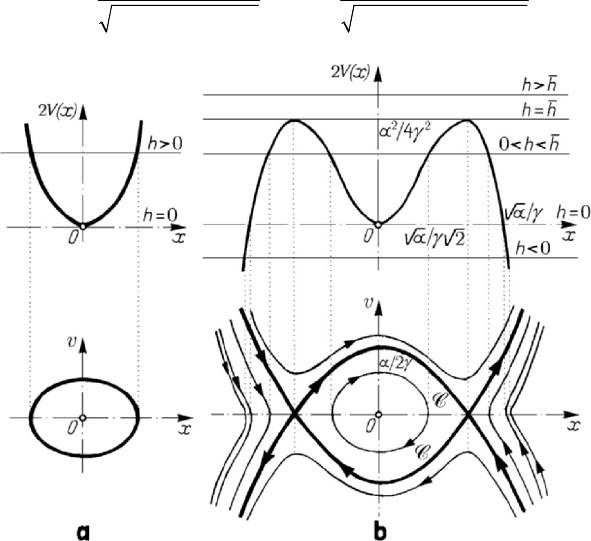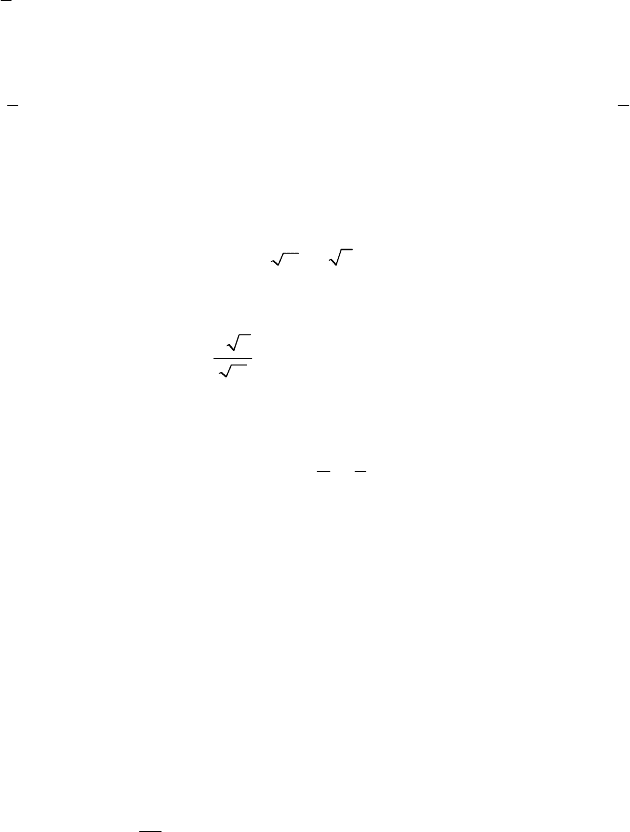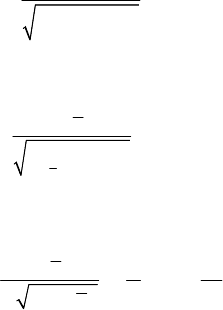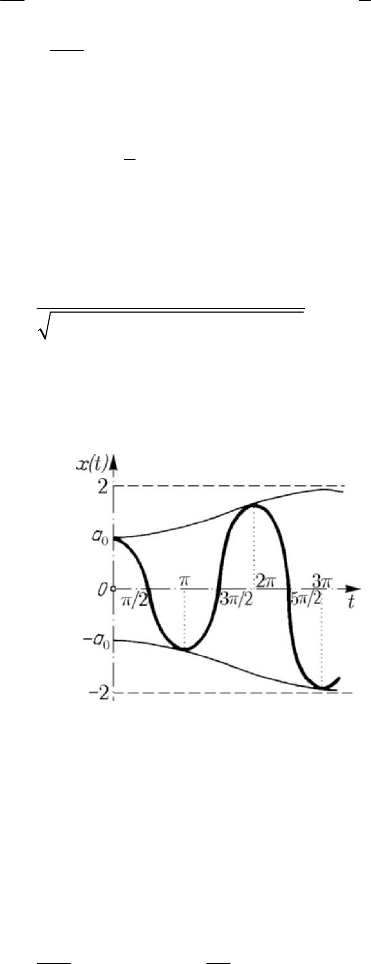Teodorescu P.P. Mechanical Systems, Classical Models Volume I: Particle Mechanics
Подождите немного. Документ загружается.


MECHANICAL SYSTEMS, CLASSICAL MODELS
532
where we take into account that the point
O is a stable position of equilibrium, the
force which acts upon the particle being directed towards this point (hence, it is equal to
F− ); we notice that the tension
0
T is of the form
0
()kl l
−
,
0
ll
<
, assuming that the
thread is tensioned beginning with a length
0
2l , for which the initial tension is zero, so
that
0
kl T> . Because
3
() 2
f
xxxαβ=+ , we have () 12 0
f
xxβ
′
′
=
> for 0x > ;
hence, the arc characteristic is strong.
In the considered case, the force
F is conservative (
24
2()Vx x xαβ=+), so that
we may use the results in Chap. 6, Subsec. 2.2.4 and Chap. 7, Subsec. 2.3.4; we obtain
thus the first integral
224
vxxhαβ++=,
24
ha aαβ=+,
(8.2.85')
where
a is the maximal elongation, for which 0v
=
. The period is given by
() ()
/2
24 2 2
00
dd
44
1sin
a
x
T
hxx a
π
θ
αβ αβ θ
==
−+ + +
∫∫
,
Figure 8.52. Motion of a particle situated at the middle of an elastic thread. Phase trajectories.
Diagrams 2()Vx vs
x
and v vs
x
: case
0β >
(a); case
0β
<
(b).
where we have made the substitution
sinxa θ
=
. If
0β >
(strong spring, case
considered above), then the frequency increases (the period decreases) together with the
amplitude; the motion is periodic, the phase trajectories being closed for any initial
conditions for which
0h ≥ (Fig.8.52,a).

Dynamics of the particle in a field of elastic forces
533
If
2
0βγ=− < (soft spring, weak characteristic), then the period increases together
with the amplitude; the potential energy has two maxima and a minimum (Fig.8.52,b).
For
22
/4hh αγ== one obtains the separation curve C, formed by arcs of parabola
22
1
(,) 2 2 0Pxv v xγγ α≡− +=,
22
2
(,) 2 2 0Pxv v xγγ α
≡
+−=.
For
hh> the phase trajectories cover the whole phase plane. For 0 hh<<
(
22
aαγ> ) one obtains closed phase trajectories, interior to the curve C, and open
curves, exterior to that one, while for
0h
<
(
22
aαγ< ) there are only open phase
trajectories; the motion is periodic only for the closed curves, in initial conditions for
which
00
1
(,) 0Px v > ,
00
2
(,) 0Px v
<
. The point O is a singular point of centre type
(stable equilibrium), while the points
(
)
/2,0αγ± are singular points of saddle
type (labile equilibrium). Making
22
/2a αγ= , one obtains
/2
0
42
sec dT
π
θθ
α
=
∫
on the separation curve; we notice that
(
)
sec d ln tan
42
πθ
θθ
=+
∫
,
so that the particle
P reaches a labile position of equilibrium after an infinite time.
The cases considered above have led to equations of the form (8.2.83') and,
precisely, of the form
() 0xfx
+
= ,
(8.2.83'')
corresponding to the non-damped free vibrations of mechanical systems with non-linear
elastic characteristics. Let us assume that
()
f
x is an odd function ( () ()
f
xfx−=− ),
symmetric with respect to the origin, and let us suppose that at the initial moment
0t = the abscissa is
0
x and the velocity vanishes (
0
0v
=
). In this case, multiplying
the equation (8.2.83'') by
x and integrating, one obtains
0
2
00
()d ()d
2
xx
x
f
fx xξξ+=
∫∫
,
a relation which corresponds, in fact, to a conservation law of the mechanical energy.
Taking into account that
d/dxxt
=
and integrating between the limits 0x = and
0
xx= , we obtain the period (assuming that
0
0x > , we take the sign minus before the
radical, because between the initial position and that of equilibrium the motion takes
place in the negative direction of the
Ox -axis)

MECHANICAL SYSTEMS, CLASSICAL MODELS
534
0
0
0
d
4
2()d
x
x
x
x
T
f
ξξ
=
∫
∫
.
(8.2.86)
In general,
0
0
d
2()d
x
x
x
x
x
t
f
ξξ
=
∫
∫
.
(8.2.86')
In particular, in the case of harmonic oscillations we have
2
()
f
xxω= and are led to
0
22
0
0
d1
arccos
x
x
xx
t
x
xx
ω
ω
==
−
∫
.
As well, if
2
() sin
f
θω θ= (great oscillations of the mathematical pendulum), then the
formula (8.2.86) allows to find again the period (7.1.39'). In general, for the equation
(8.2.84) (and analogously for the equation (8.2.85)) the formula (8.2.86') leads to
elliptic integrals of the first kind, as it was to be expected.
The damped free vibrations of mechanical systems with non-linear elastic
characteristics lead to an equation of the form
() (,) 0xfx gxx
+
+= ,
(8.2.87)
while the parametric vibrations of non-damped mechanical systems are modelled by an
equation of the form
2
() 0xtxω
+
= .
(8.2.87')
Sometimes, in case of small non-linearities, we may introduce a small parameter
ε ,
obtaining quasi-linear equations of the form
2
0
() 0xxfxωε
+
+= ,
(8.2.88)
[
]
2
0
() () 0xxfxgxωε++ + =
,
(8.2.88')
2
0
(, ) 0xxfxxωε++ = .
(8.2.88'')
We mention thus the Van der Pol equation (for self-excited vibrations)
(
)
2
10xx xxλ+− − = , 0λ > ,
(8.2.89)
Rayleigh’s equation (for small non-linear dampings)
(
)
3
0xx mx nxε++ − = , ,0mn> ,
(8.2.90)
Froude’s equation (for dampings in a turbulent motion of fluids)
Dynamics of the particle in a field of elastic forces
535
2
0xxpxqxγ
+
++= ,
(8.2.90')
Duffing’s equation (for the response to a harmonic excitation of mechanical systems
with non-linear elastic characteristics)
3
cosxxxcxq tαβ ω++ += , 0c ≥ ,
(8.2.91)
Mathieu’s equation (for a harmonic variation in time of the rigidity)
(
)
22
00
cos 0xtxωα ω++ = ,
(8.2.92)
and Hill’s equation (for the periodic variation in time of the rigidity)
2
0
1
cos 0
n
n
xntxωαω
∞
=
⎛⎞
++ =
⎜⎟
⎝⎠
∑
;
(8.2.92')
the study of these equations has put in evidence the most important non-linear
phenomena and the corresponding basic methods of solution.
In general, for a free vibratory motion is searched a periodic solution (if there exists
such a solution for the given initial conditions) and a study of its stability is made. In
case of forced vibrations, the form of the response curves of the mechanical system (the
relation between the amplitude and the frequency of the motion and the corresponding
characteristics of the perturbing force) is searched too. The non-linear vibrations are
non-isochronous, because the period
T depends on the amplitude. As well, besides the
problem of static stability, the problem of dynamic stability must be also considered.
We have seen that the response of a damped linear system on which acts a sinusoidal
perturbing force of pulsation
ω is a harmonic vibration, having the same pulsation; in
case of a non-linear system appear pulsations
nω , n
∈
` , too, called also
superharmonics (multiples of the excitation pulsation) or even pulsations
/nω ,
n ∈ ` , called subharmonics (submultiples of the excitation pulsation). In case of the
action of two independent perturbing forces upon a non-linear system, one can no more
use the principle of superposition of effects; by the superposition of two distinct
excitations, appears an interaction between the oscillations which arise, leading to the
phenomenon of asynchronous suppression (if each of the independent vibrations is
stable, then one of the motions destroys the stability conditions of the other one), to the
phenomenon of asynchronous excitation (one of the independent vibrations is labile,
the other one being stable and creating the conditions that the first one become stable
too) or to the phenomenon of carrying the pulsations (if the independent vibrations
have close pulsations which, in a certain zone of values, synchronize).
2.2.14 Computation methods
The problems which arise in the study of non-linear oscillations are difficult, so that
their solution needs specific methods of computation, especially approximate ones. We
have thus presented in Chap. 7, Subsec. 2.3.4 topological methods of computation in

MECHANICAL SYSTEMS, CLASSICAL MODELS
536
the phase space, which have been used in the previous subsection. In what follows we
pass in review some approximate methods of computation.
Let be the quasi-linear equation (which intervenes in case of the mathematical
pendulum)
23
0
0xxxωε
+
+= ,
(8.2.93)
a particular case of the equation (8.2.88). In S.P. Timoshenko’s method we assume that,
in a first approximation,
() cosxt a tω
=
(8.2.93')
represents a harmonic motion of pulsation
ω , which differs not much from
0
ω and for
which the initial conditions
(0)xa
=
, (0) 0x
=
(8.2.93'')
are verified. We notice that
22 2
0
ωω ω
=
+Δ ,
222
0
ωωωΔ= −, and put the condition
that the solution (8.2.93') verifies the equation (8.2.93), obtaining thus
(
)
22 33 23 3
31
cos cos cos cos 3
44
xxa ta t a a ta t
ωωωεωωεωεω+=−Δ − =−Δ+ − .
The first term of the second member represents a perturbing element with the same
pulsation as the proper one of the terms in the first member; but this term must be
equated to zero (
23
3/40aaωεΔ+ =) to can eliminate the phenomenon of resonance.
With the same initial conditions, we obtain, in a second approximation, the solution (to
the general solution of the homogeneous equation we add a particular solution of the
complete equation)
33
22
() cos cos3
32 32
aa
xt a t t
εε
ωω
ωω
⎛⎞
=− +
⎜⎟
⎝⎠
,
(8.2.93''')
with
22 2
0
3
4
a
ωω ε=+ .
(8.2.94)
Analogously, we may use the Ostrogradskiĭ-Lyapunov method, based on successive
approximations too. We choose thus the solution in the form of a polynomial in
ε (we
consider only the first three approximations)
2
0
12
xx x xεε=+ + ,
(8.2.95)
where
00
()xxt
=
,
11
()xxt= ,
22
()xxt
=
are functions of class
2
C ; as well, we
take (we retain only three terms)

Dynamics of the particle in a field of elastic forces
537
22 2
0
12
CCωω ε ε=+ + ,
(8.2.95')
where
2
12
,,CCω are non-determinate constants. Replacing in (8.2.93) and equating to
zero the coefficients of the powers of
ε , we obtain
2
0
0xxω+=
,
23
00
111
0xxCxxω
+
++=
,
22
00
22112 1
30xxCxCxxxω++++ = .
The first of these equations leads (for
0
x ) to the first approximation (8.2.93') with the
same initial conditions (8.2.93''); replacing
0
x in the second equation and determining
1
C so that the phenomenon of resonance be eliminate, we find again for
0
1
xx xε=+
the same approximation (8.2.93'''). Analogously, we may determine
2
x , thus the third
approximation a.s.o. We notice that the two methods of successive approximations are
– as a matter of fact – equivalent, differing only by the modality of approaching the
computation. The non-linearity of the considered phenomenon has introduced
superharmonics in the equation (8.2.93) (harmonics of third order in the approximation
of second order).
In case of the equation (8.2.83'') we introduce the square deviation
[
]
2
2
()
f
xxωΔ= − between the non-linear term and the linear approximation; using
the solution in the linear case
cosxa tω
=
, we obtain the mean square deviation on the
duration of a period
[][]
2
22
22 2
00
11
( cos ) cos d ( cos ) cos d
2
T
fa t a t t fa a
T
π
ωω ω θω θθ
π
=−= −
∫∫
A ,
where a change of variable
tωθ
=
has been made. Imposing the condition that
2
A
be
minimal (the least squares method), hence the condition
2
/0ω
∂
∂=A , we are led to
2
2
0
1
(cos)cosdfa
a
π
ωθθθ
π
=
∫
,
(8.2.96)
wherefrom we deduce
2/T πω= . In particular, in case of the equation (8.2.93), the
formula (8.2.96) leads to the pulsation (8.2.94), so that
2
2
0
22
0
0
223
1
8
3
4
a
T
a
ππ
ε
ω
ω
ωε
⎛⎞
=≅−
⎜⎟
⎝⎠
+
,
(8.2.94')
in case of a small parameter
ε . We notice that for 0ε > (non-linear vibrations with
strong characteristic) the period decreases with the amplitude, while for
0ε < (non-
linear vibrations with weak characteristic) the period increases with the amplitude; if
0ε = , then the vibrations are isochronous. We may thus easily determine,
experimentally, the nature of these vibrations.

MECHANICAL SYSTEMS, CLASSICAL MODELS
538
In the harmonic balance method, the condition that the term in
cos tω of the
development into series of the function
(cos )
f
atω be identical to the corresponding
term
2
cosatωω in the associated linear differential equation is put; thus, the formula
(8.2.96) is found again.
Other approximate methods of computation are based on the so-called variation of
constants, differing after the constants which are varied. We mention, e.g., Van der
Pol’s averaging method. In the Krylov-Bogolyubov method, the basis of which is the
first approximation theory, the constants which vary are the amplitude and the phase of
the motion of the non-linear system. However, the method has numerous variants, e.g.
the Bogolyubov-Mitropol’skiĭ variant.
We mention the equivalent linearization method (Krylov-Bogolyubov) too, as well as
Galerkin’s method.
Thus, in case of the quasi-linear equation (8.2.88'') we start from the harmonic
solution
0
sin( )xa tωϕ=−,
00
cos( )xa tωωϕ
=
− ,
and take the amplitude
()aat
=
and the phase shift ()tϕϕ
=
as new unknowns,
functions of time, which must be determined. Differentiating with respect to time, we
obtain
0000
sin( ) cos( ) cos( )xa t a t a tωϕϕωϕ ω ωϕ=−− −+ − ;
taking into account the expression of the velocity which corresponds to the linear case,
there results the condition
00
sin( ) cos( ) 0at a tωϕϕωϕ
−
−−= .
Starting from the same expression of the velocity, we may write
2
00 0 0 00
cos( ) sin( ) sin( )xa t a t a tωωϕωϕωϕωωϕ=−+ −−− ,
and taking into account the equation (8.2.88''), we get
00 0 0
cos( ) sin( )at a tωωϕωϕωϕ−+ −
(
)
000
sin( ), cos( )
f
ata tεωϕωωϕ
=
−− −;
using also the condition previously obtained, we get the differential equations of first
order (instead the differential equation of second order)
()
000 0
0
sin( ), cos( ) cos( )afata t t
ε
ωϕω ωϕ ωϕ
ω
=− − − −
,
()
000 0
0
sin( ), cos( ) sin( )fa t a t t
a
ε
ϕ ωϕω ωϕ ωϕ
ω
=− − − −
.
(8.2.97)
We notice that the function
f
has the period
0
2/T πω
=
and that a and ϕ vary
slowly in time; these derivatives may be taken equal to their mean values
mean
a and

Dynamics of the particle in a field of elastic forces
539
mean
ϕ on a period (considered to be approximately equal to T ). In a period, the angle
0
tψω ϕ=− varies by 2π , so that
22
mean
00
0
1
d(sin,cos)cosd
22
aa faa
ππ
ε
ψψωψψψ
ππω
==−
∫∫
,
22
mean
00
0
1
d ( sin , cos )sin d
22
fa a
a
ππ
ε
ϕϕψ ψωψψψ
ππω
==−
∫∫
,
(8.2.97')
corresponding to the first terms in the respective development into Fourier series. For a
better approximation, one may take terms of higher rank in these expansions.
If
()
f
fx= , () ()
f
xfx−=− , then we may write
22
00
00
(sin )cos d ()d 0
22
afa fxx
a
ππ
εε
ψψψ
πω π ω
=− =− =
∫∫
,
0
constaa
=
= .
(8.2.97'')
We obtain thus the approximate solution
[
]
0
() sin ( )xt a atωψ
=
− ,
(8.2.97''')
the pulsation depending on the amplitude, as an effect of the non-linearity. Squaring the
second relation (8.2.97') and neglecting
2
ε , we find the remarkable relation
2
22
0
0
( ) ( sin )sin dafa
a
π
ε
ωω ψψψ
π
=+
∫
.
(8.2.97
iv
)
For instance, in case of the equation (8.2.84), we obtain
2
2
234
0
11
sin d 1
68
gg g
ll l
π
α
ωαψψ
πα
⎛⎞
=− = −
⎜⎟
⎝⎠
∫
,
where
max
αθ
=
is the amplitude of the mathematical pendulum; it results the period
2
2
2
21 1
2221
16
1
1
16
8
lll
T
ggg
πα
πππ
ω
α
α
⎛⎞
== ≅ ≅ +
⎜⎟
⎝⎠
−
−
,
finding again the approximate formula (7.1.43''') (if we limit ourselves to the first two
terms in the considered developments).
Let be also the Van der Pol equation (8.2.89) with the initial conditions
0
(0)xa= ,
(0) 0x = . Observing that
0
1ω
=
, ελ
=
− ,
(
)
2
(,) 1
f
xx x x=−
(the unit having the
necessary dimension), we start from the harmonic solution
sin( )xa tϕ
=
− ; the initial
conditions lead to
0
(0) (0)sin (0)xa aϕ=− = , (0) (0)cos (0) 0xa ϕ
=
= , so that
0
(0)aa=− , (0) /2ϕπ= . The formulae (8.2.97') give the mean values

MECHANICAL SYSTEMS, CLASSICAL MODELS
540
() ()
2
22 2
mean
0
1
1 sin ( cos )cos d 4
28
aaa aa
π
λ
ψψψψλ
π
=− =−
∫
,
()
2
22
mean
0
1 sin ( cos )sin d 0
2
aa
a
π
λ
ϕψψψψ
π
=− =
∫
,
the system of differential equations of first order (8.2.97) becoming thus
()
2
1
4
8
aaaλ=−
, 0ϕ
=
.
Separating the variables in the first equation, integrating by decomposition in simple
fractions and taking into account the initial conditions for the new variables, we may
write
[]
0
22
00
() cos
(/2) 1(/2)e
t
a
xt t
aa
λ−
=
+−
;
(8.2.98)
this result corresponds to an aperiodic oscillatory motion, hence to a vibration
modulated in amplitude, which tends asymptotically to 2 (in Fig.8.53 we assume that
0
2a < ).
Figure 8.53. Van der Pol equation. Diagram ()xt vs t .
The perturbations method, initiated by Poincaré, allows also an approximate study of
the differential equations with a small parameter. Let thus be an autonomous
mechanical system, the motion of which is modelled by a non-linear differential
equation of the form (8.2.88'') for which
(0,0) 0
f
=
, with the initial conditions
(8.2.93''). By the change of variable
tωτ
=
, where ω is a unknown pulsation, one
obtains an equation of the form
(
)
2
22 2
0
2
dd
,, 0
d
d
xx
xxωωεϕω
τ
τ
++ =
,
(8.2.99)
where
ϕ is a given non-linear function; the initial conditions become 0x = ,
d/d 0x τ = for 0τ = . In the perturbations method one considers both for the

Dynamics of the particle in a field of elastic forces
541
solution
()x τ and for the square of the unknown pulsation ω , developments into
power series after the small parameter
ε , i.e.
2
0
12
() () () () ...xx x xττετετ=+ + +,
(8.2.100)
22 222
0
12
...ωωεωεω=+ + +.
(8.2.100')
The initial conditions are verified if
0
xa
=
,
12
... 0xx
=
==,
0
d/dx τ
1
d/dx τ=
2
d/d ... 0x τ===. Replacing in the equation (8.2.99), developing the function ϕ
(which we assume to be analytical) into a Taylor series, arranging the terms after the
powers of the small parameter
ε , and equating to zero the coefficients of those powers
(assuming successively, that one may neglect the higher powers of
ε with respect to
the lower ones), we get the equations
2
0
22
000
2
d
0
d
x
xωω
τ
+
= ,
(
)
2
2
100
222 2
00 00
11
22
d
dd
,,
d
dd
x
xx
xx
ωωωϕ ω
τ
ττ
+=− −
,
22
2
210
2222
00
21 2
222
dd
d
ddd
xx
x
x
ωωωω
τττ
+=− −
(
)
(
)
(
)
1
2
11
2
00
0
d
d
x
x
xx
ϕϕϕ
ω
τ
ω
∂∂∂
−− −
∂∂
∂
,
. . . . . . . . . . . . . . . . . . . . . . . . . . . . . .
(8.2.100'')
In the first approximation, the small parameter ε is neglected; the first equation
(8.2.100'') leads to the solution
00
cos cos cosxa a ta tτω ω== = , (8.2.101)
which satisfies the initial conditions. In the second approximation,
23
, ,...εε are
neglected with respect to
ε , hence one takes
0
1
() () ()xx xττετ
=
+ ,
2
ω
22
0
1
ωεω=+ . Replacing the solution (8.2.101) in the second equation (8.2.100''), it
results
()
2
1
22
00
11
2
d
cos cos , sin ,
d
x
xa a a
ωωτϕττω
τ
⎛⎞
+= − −
⎜⎟
⎝⎠
,
with the initial conditions
1
0x
=
,
1
d/d 0x τ
=
for 0τ
=
. In the second member of
the differential equation appear terms in
cos τ and sin τ (secular terms), which lead to
non-periodic particular solutions of the form
cosττ and sinττ. Because we search
periodic solutions, we equate to zero the coefficients of those terms, obtaining
supplementary conditions; we get thus
1
ω and may then integrate the differential
equation. The procedure can be applied further, obtaining thus approximations of
higher order (a solution
()x τ in the form of an expansion into a Fourier series).
